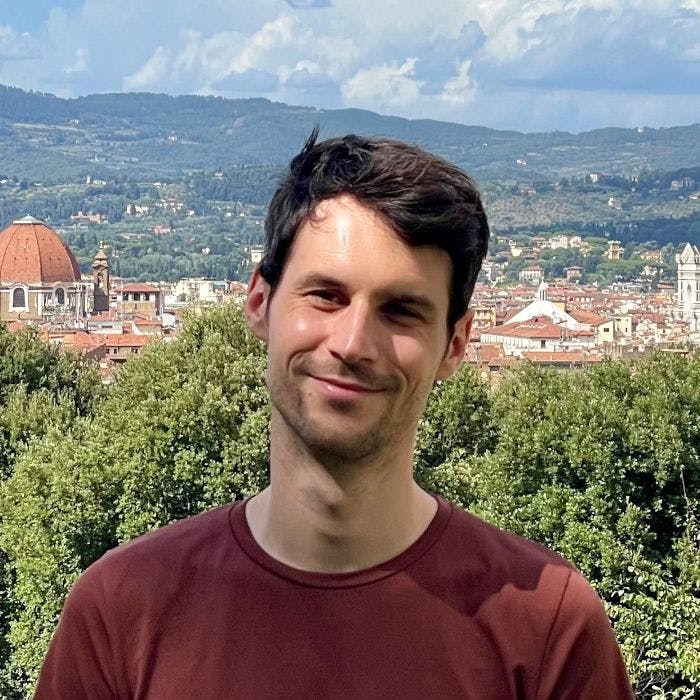

Pierre van der Bruggen
Institut de Duve Avenue Hippocrate 74 - B1.74.03 1200 Bruxelles
The van der Bruggen Lab tries to understand why tumor-infiltrating lymphocytes fail to destroy tumor cells in order to identify new therapeutic targets.
Major achievements
- Identification of gene MAGE-A1 encoding the first human tumor antigen recognized by CD8 T cells.
- Identification of lectin Galectin-3 as a factor responsible for the dysfunction of human tumor-infiltrating lymphocytes.
- Demonstration that human suppressive neutrophils are mature and not immature, as often reported.
Research
Question
How to distinguish a suppressive human neutrophil and how does it exert its suppressive activity on T lymphocytes?
How to inhibit this suppression mechanism to develop new cancer immunotherapies?
Research focus

Lung cancer is the leading cause of cancer-related deaths worldwide. Immunotherapy is a groundbreaking advancement in cancer treatment, as evidenced by the success of immune checkpoint blockers, which primarily target T lymphocytes. Recognizing that a significant proportion of tumors do not respond to current treatments, we have embarked on an investigation into the roles of other immune cells—neutrophils. Indeed, their accumulation within patients’ tumors correlates with a negative clinical prognosis. Despite clinical indications of their significance, the biology and function of neutrophils in cancer patients remain inadequately explored.
For more than 7 years, we have compared the presence, transcriptome and function of tumor-associated neutrophils and blood neutrophils. In the blood, we compare classical neutrophils (most abundant circulating neutrophils), and low-density neutrophils. We perform transcriptome analyses and test in vitro the suppressive activity of each neutrophil sample. We mainly analyze samples of lung cancer patients. We are member of the European COST Action MyeInfoBank, which aims to validate molecular signatures associated with myeloid regulatory cells.
Our overarching objective is to identify novel neutrophil targets for cancer immunotherapy. Since targeting all neutrophils is impractical, we aim to identify specific markers of immunosuppressive neutrophils and/or uncover the mechanisms used by neutrophils to mediate T-cell suppression.
Projects
- The suppressive impact of human neutrophils on CD8 T Cells
- Unveiling the suppressive mechanisms of human neutrophils
- Neutrophils in Lung Health and Disease, including cancer
- Neutrophils in Immune Checkpoint Inhibitors-associated side effects
- Influence of IRF4 and IRF8 on human CD8 T Cells
- Promoting human T cell stemness in artificial immune niches
Diseases
Bio
Pierre van der Bruggen completed his Ph.D. in Agronomical Sciences in 1987, focusing on a fungus pathogenic to cassava. In 1988, he joined Professor Thierry Boon at the Ludwig Institute for Cancer Research branch in the de DUVE Institute. Pierre van der Bruggen now holds the position of Full Professor at the Medical Faculty of the Université catholique de Louvain. In 1991, Pierre van der Bruggen identified the first human gene, MAGE-1, encoding a tumor antigen recognized by cytolytic T lymphocytes. His group identified numerous other cancer germline genes and antigenic peptides recognized by T cells on tumors. They have also developed assays to monitor CD4+ T cell responses to cancer vaccines and contributed to the study of MAGE-3-specific regulatory T cells. His group discovered a novel form of dysfunction in human tumor-infiltrating lymphocytes caused by the presence of galectin-3, a lectin abundant in tumors. T cell dysfunction was successfully reversed using galectin ligands and anti-galectin-3 antibodies.
Honors
- 2009 Prize “Wivine et Jacques Allard-Janssen”
- 1998 Prize of the “Fondation Alexandre et Gaston Tytgat”
- 1995 Prize of the “Fondation Maggy et Robert de Hovre”
Affiliations
- Group Leader, de Duve Institute
- Full professor (professeur extraordinaire), UCLouvain
- Former Member of the Ludwig Institute for cancer research (1988-2017)
Team
Clinical Investigator
Postdoctoral Scientist
PhD Students
Research Assistants
Administrative Support

IRF4 impedes human CD8 T cell function and promotes cell proliferation and PD-1 expression
Hirsch T, Neyens D, Duhamel C, Bayard A, Vanhaver C, Luyckx M, Sala de Oyanguren F, Wildmann C, Dauguet N, Squifflet JL, Montiel V, Deschamps M, van der Bruggen P
Cell Rep (2024) 43(7):114401
HELIOS-Expressing Human CD8 T Cells Exhibit Limited Effector Functions
Neyens D,Hirsch T, Achraqat Abdel Aziz Issa Abdel Hadi, Dauguet N, Vanhaver C, Bayard A, Wildmann C, Luyckx M, Squifflet JL, D’Hondt Q, Duhamel C, Huaux A, Montiel V, Dechamps M, van der Bruggen P
Front Immunol (2023) 14:1308539
Immunosuppressive low-density neutrophils in the blood of cancer patients display a mature phenotype
Vanhaver C, Aboubakar Nana F, Delhez N, Luyckx M, Hirsch T, Bayard A, Houbion C, Dauguet N, Brochier A, van der Bruggen P, Bruger AM
Life Sci Alliance (2023) 7(1):e202302332
Restoring the association of the T cell receptor with CD8 reverses anergy in human tumor-infiltrating lymphocytes.
Demotte N, Stroobant V, Courtoy PJ, Van Der Smissen P, Colau D, Luescher IF, Hivroz C, Nicaise J, Squifflet JL, Mourad M, Godelaine D, Boon T, van der Bruggen P.
Immunity (2008) 28:414-424.
A gene encoding an antigen recognized by cytolytic T lymphocytes on a human melanoma
van der Bruggen P, Traversari C, Chomez P, Lurquin C, De Plaen E, Van den Eynde B, Knuth A, Boon T.
Science (1991) 254:1643-1647.










